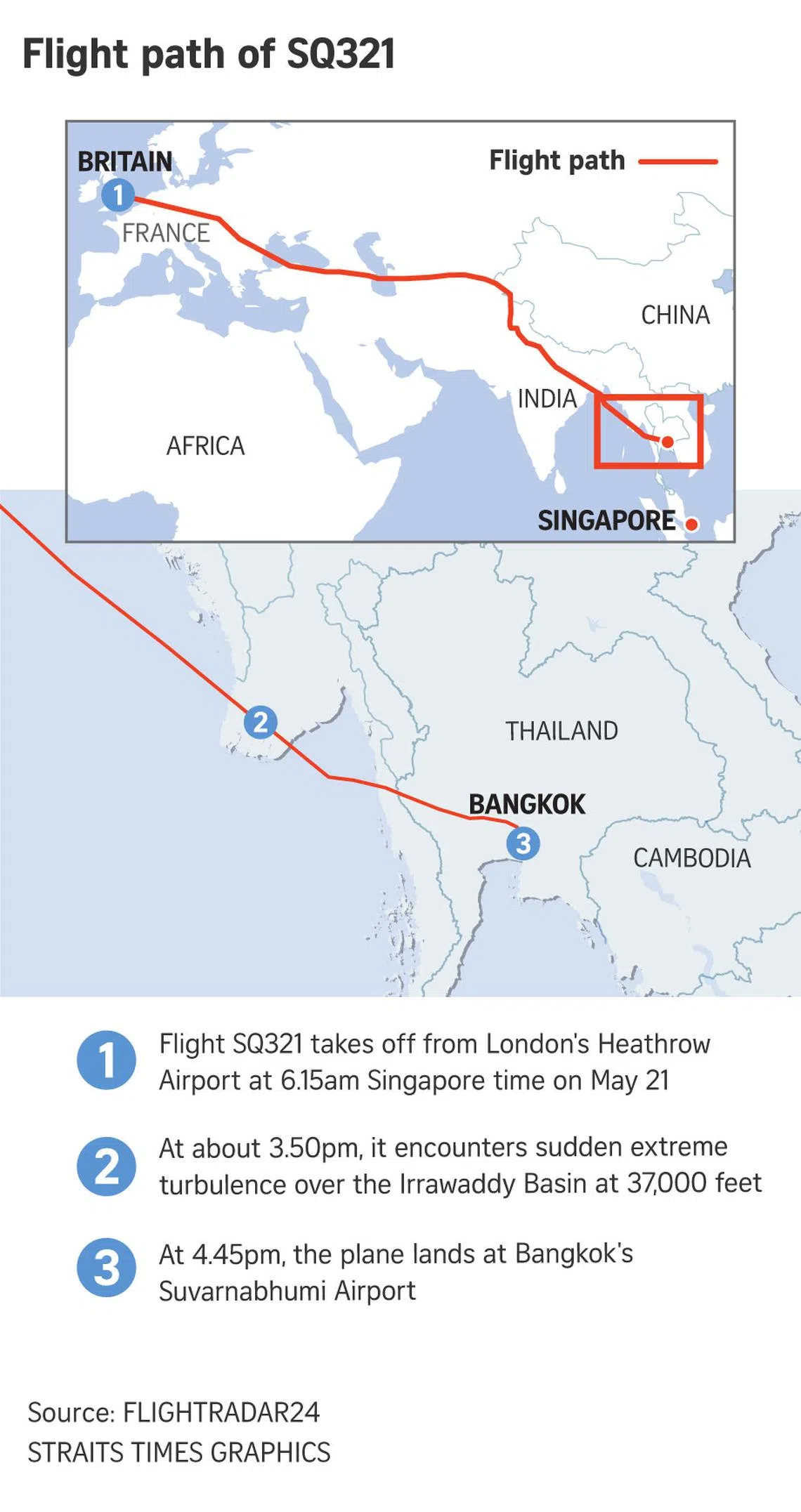One dead, dozens injured after Singapore Airlines flight from London hit by severe turbulence
Sign up now: Get ST's newsletters delivered to your inbox
Follow topic:
SINGAPORE - One passenger died and dozens were injured when an SIA flight heading to Singapore from London’s Heathrow Airport encountered severe turbulence.
In a Facebook post on May 21, Singapore Airlines (SIA) said the Boeing 777-300ER aircraft experienced “sudden extreme turbulence” over the Irrawaddy Basin about 10 hours after departing from London.
The pilot declared a medical emergency and landed at Thailand’s Suvarnabhumi Airport at 3.45pm (4.45pm Singapore time).
The airline said 18 passengers have been hospitalised, with another 12 receiving treatment for their injuries in hospitals. The remaining passengers and crew were examined and treated at the airport, it added.
The 211 passengers on Flight SQ321 included 41 Singaporeans, with the remaining 170 from countries such as Australia, Malaysia, New Zealand and Britain. There were 18 crew members on board.
Mr Kittipong Kittikachorn, general manager of Suvarnabhumi Airport in Bangkok, said at a press briefing that a 73-year-old British passenger died on the flight, likely due to a heart attack. He said the man’s wife was taken to hospital, but did not elaborate on her condition.
The dead passenger was later identified as Mr Geoffrey Kitchen.
Mr Kittipong added that dozens of passengers were hurt, with seven of them critically injured. Nine crew members were also taken to hospital, he said.
SIA has sent 50 staff to Bangkok to help the affected passengers, he said. Chinese-language daily Lianhe Zaobao reported that the flight for this group of SIA employees took off at about 8.30pm.
In its post, SIA offered its deepest condolences to the family of the passenger who died, and said: “We deeply apologise for the traumatic experience that our passengers and crew members suffered on this flight.”
Mr Kittipong said the plane fell into an air pocket while the cabin crew were serving breakfast before it encountered turbulence, prompting the pilot to request an emergency landing in Bangkok.
In a blog post, FlightRadar24 said there were thunderstorms in the area, some severe, when SQ321 encountered turbulence at 2.19pm local time.
Data showed that the flight encountered a rapid change in vertical rate, consistent with a sudden turbulence event, and that the unexpected changes lasted for nearly one minute, it said.
The live flight tracker said the aircraft may have continued to experience turbulence during its initial descent towards Bangkok from 37,000 feet (11,280m) to 31,000 feet, but this was “a standard descent to a new flight level”.
Passengers on board said those not wearing their seatbelts were thrown upwards, with some hitting the baggage cabins above them.
Images and videos circulating online showed patches of blood on the cabin floor, with debris – including food, disposable cutlery, and bottles of wine and water – strewn around.
Some ceiling panels were damaged, with the internal tubing exposed and dangling.
Malaysian student Dzafran Azmir, 28, told Reuters after the incident that he started bracing himself when the aircraft began tilting up and shaking.
“Suddenly there was a very dramatic drop, so everyone seated and not wearing a seatbelt was launched immediately into the ceiling. Some people hit their heads on the baggage cabins overhead and dented them, they hit the places where lights and masks are, and broke straight through,” he said.
“The crew and people inside lavatories were hurt the most because we discovered people just on the ground, not able to get up. There were a lot of spinal and head injuries,” he added.
Mr Andrew Davies, a passenger on the flight, said in a post on social media platform X that the man who died was flying with his wife.
He added that many others were injured, with some suffering head lacerations and experiencing bleeding ears, while their belongings were scattered all over the plane.
Singapore’s leaders took to social media platform Facebook to offer their condolences and pledge their support.
In a post, Prime Minister Lawrence Wong said: “We are working closely with the Thai authorities and doing everything we can to support the passengers and crew.”
President Tharman Shanmugaratnam said he was greatly saddened by the death and the injuries.
Transport Minister Chee Hong Tat said officials from the Ministry of Transport, Ministry of Foreign Affairs, Civil Aviation Authority of Singapore and Changi Airport Group – as well as SIA staff – are providing support to the affected passengers and their families.
A Ministry of Transport spokesman said the Transport Safety Investigation Bureau (TSIB) is investigating the incident.
“TSIB is in touch with its Thai counterparts and will be deploying investigators to Bangkok,” he added.
Mr Chow Kok Wah, 70, a former airline executive with more than 30 years of experience in the sector, said severe turbulence is very rare.

Speaking to The Straits Times, he said such incidents are usually not fatal if passengers and cabin crew are seated and properly belted up. “If not, one risks hitting the ceiling or getting hit by flying objects,” he added.
Mr Chow said modern jet planes are designed to handle all types of turbulence, and pilots are usually able to see patches of bad weather on their radars, and usually have time to prepare – about five to 10 minutes – depending on how fast the plane is flying.
The exception is when there is what is known as “clear air turbulence”, which Mr Chow said occurs suddenly and is not detectable by radar.
This type of turbulence is caused by a sharp difference in air temperature and density, he added.
“It looks good but when you fly through it, suddenly the density of the air is much lower, so the plane falls. And this can happen very rapidly.”
Additional reporting by Tan Hui Yee in Bangkok


